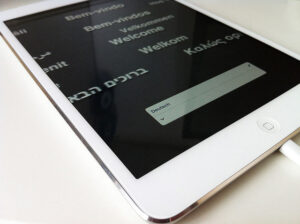It’s challenging to find your customers, but it probably shouldn’t be, right? I mean, you create a product and find a market and there you go. Business 101.
Today, however, it’s more challenging than it’s ever been. Your customers are living on their terms, not yours. They are doing their best to avoid your direct marketing and advertising. They are living their lives with or without you.
Something I stress to clients is how no customer will ever be as obsessed with your brand as you are! They are carrying on and fitting your brand into their lives.
 Today, consider how and where your customers might be interacting with your company. Take, for instance, the demand for mobile apps. When users interact with apps, they have expectations for how they should work. Today’s multi-channel users don’t necessarily think “well, designing for mobile is different than designing for the web, so I can expect an uglier, less efficient experience.” They instead think “I have something to do and I have 5 minutes on the train. I wonder if I can do this on my phone!?” When it works, it still feels special and convenient, a driving factor for customer loyalty.
Today, consider how and where your customers might be interacting with your company. Take, for instance, the demand for mobile apps. When users interact with apps, they have expectations for how they should work. Today’s multi-channel users don’t necessarily think “well, designing for mobile is different than designing for the web, so I can expect an uglier, less efficient experience.” They instead think “I have something to do and I have 5 minutes on the train. I wonder if I can do this on my phone!?” When it works, it still feels special and convenient, a driving factor for customer loyalty.
Apps that work well are extremely valuable, but there is limited real estate for each user. By real estate I mean there is a finite amount of apps someone will actually use as well as a finite limit to how many the user will actually have brain bandwidth available. Ever download an app and then find it months later, after the time when use was justified? Yeah, we all have. It feels silly to see it there, past it’s usefulness, and delete it without really caring.
Some ideas about our mobile world and how to connect with brain bandwidth of your users:
- Apps serve a function that users expect while on the go. If your app is really just an extremely limited version of something you offer, and it doesn’t work the way a mobile customer would expect, don’t release it. Improve your mobile web site instead.
- Don’t fall for the “every company needs an app” line. They don’t. If your business is focused on location, like a restaurant or hair salon, consider how your users will need you while mobile. They might want to make an appointment or reservation. They will most likely look up the business on their mobile browser, and if your home page is not optimized for that mobile moment, you’re making it difficult for your customers. Create a home page for mobile that has the most frequent actions – with a click-to-call phone number prominently displayed!
- Mobile payment is on the rise. Create scenarios that make it easier for your mobile customers who prefer this method.
- B2B is full of opportunities for apps that work well within the mobile environment. LinkedIn took a long time to release their first mobile app, but what they did release worked well across many devices for what LinkedIn users wanted. It was easy to look up new contacts, connect and search. LinkedIn has also continued to improve the experience.

- Mobile means more than using something via a smart phone. Tablets are tucked into handbags and balancing on laps at ballgames. The tablet experience should support more than the phone experience in many cases. Consider how your users might want to accomplish something in their “OMG” moments. OMG I forgot to pay that bill. OMG I need to submit something so my boss doesn’t know I’m at the ballgame. OMG I want to check those numbers right now before walking into the meeting. OMG I need to order that gift.
- Any cloud-based user situation should have apps and mobile sites that support this type of engagement. If you want your customers to access via the cloud, they expect to access the cloud anywhere.
How can you improve the mobile customer experience for your customers? They are out there. You just need to find them!
Photo credit: theunquietlibrary and icatus via Creative Commons license



